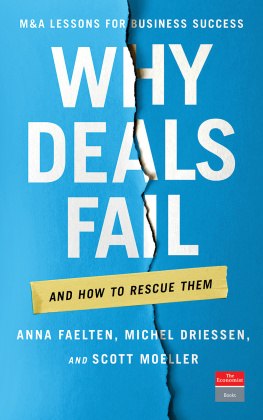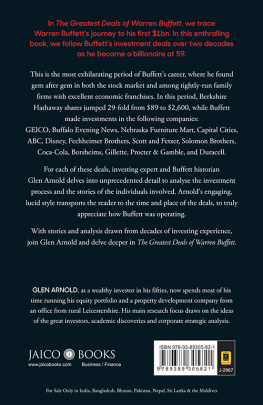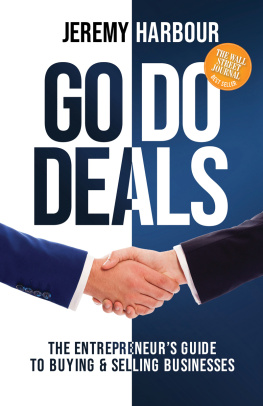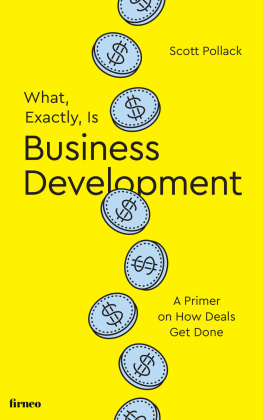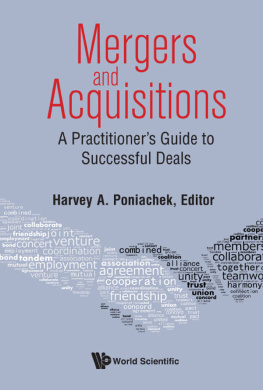WHY DEALS FAIL
ANNA FAELTEN is a corporate finance adviser at EY (Ernst & Young), an international accountancy and professional-services firm. She has ten years of experience in mergers and acquisitions (M&A), predominantly advising firms in the technology, media and telecommunications sector. She is a visiting lecturer at Cass Business School, where she teaches M&A to masters degree students. She remains active with her academic research, which focuses on M&A but also encompasses general corporate finance, corporate governance, corporate distress, and restructuring and investment in emerging markets.
MICHEL DRIESSEN is a senior partner within the transaction advisory services practice at EY. He has previously held senior executive positions at Accenture, Visa and Rabobank. During his nine years at EY he has worked on and led over 100 multibillion-pound transactions with the worlds largest corporates and private equity firms on some of the biggest and most complex cross-border engagements. His focus has been on synergy identification and valuation, post-merger integration, divestments/carve-outs and operational restructuring. He is an advisory board member of the M&A Research Centre and a senior visiting fellow at Cass Business School.
SCOTT MOELLER is a professor in the practice of finance at Cass Business School, where he is also director of the M&A Research Centre. He is a former investment banker at both Morgan Stanley and Deutsche Bank, a former consultant at Booz Allen Hamilton, co-author of Intelligent M&A: Navigating the Mergers and Acquisitions Minefield (now in its second edition), author of Surviving M&A: Make the Most of Your Company Being Acquired, and editor of Finance Essentials: The Practitioners Guide and M&A Collection: Themes in Best Practice.

The Economist in Association with Profile Books Ltd. and PublicAffairs
Copyright Anna Faelten, Michel Driessen and Scott Moeller, 2016.
First published in 2016 by Profile Books Ltd. in Great Britain.
Published in 2016 in the United States by PublicAffairs,
an imprint of Perseus Books, LLC, a subsidiary of Hachette Book Group, Inc.
All rights reserved.
Printed in the United States of America.
No part of this book may be reproduced, stored in or introduced into a retrieval system, or transmitted, in any form or by any means (electronic, mechanical, photocopying, recording or otherwise), without the prior written permission of both the copyright owner and the publisher of this book, except in the case of brief quotations embodied in critical articles and reviews. For information, address PublicAffairs, 250 West 57th Street, 15th Floor, New York, NY 10107.
The greatest care has been taken in compiling this book. However, no responsibility can be accepted by the publishers or compilers for the accuracy of the information presented.
Where opinion is expressed it is that of the author and does not necessarily coincide with the editorial views of The Economist Newspaper.
While every effort has been made to contact copyright-holders of material produced or cited in this book, in the case of those it has not been possible to contact successfully, the author and publishers will be glad to make amendments in further editions.
PublicAffairs books are available at special discounts for bulk purchases in the U.S. bycorporations, institutions, and other organizations. For more information, please contactthe Special Markets Department at the Perseus Books Group, 2300 Chestnut Street,Suite 200, Philadelphia, PA 19103, call (800) 810-4145, ext. 5000, or e-mail
Library of Congress Control Number: 2016945398
ISBN 978-1-61039-790-2 (PB)
ISBN 978-1-61039-791-9 (EB)
First Edition
1 0 9 8 7 6 5 4 3 2 1
To Mattias, with all my love
AF
To Celine, Edsard and Jasper, the pride in my life
MD
To Daniela, Christine, Andrew, Ellen and Jonathan, with love
SM
Figures and tables
Figures
Tables
Preface
IF THE GLOBAL ECONOMY had a characteristic sound when this book was being written, it was champagne corks popping in the offices of merger & acquisition (M&A) advisers from London to Shanghai and New York. Global dealmaking escaped its austerity shackles, breaking the $5 trillion barrier in 2015 and easily eclipsing the $3.7 trillion record set in 2007, according to data on announced deals compiled by Dealogic.
Whether future years match or even exceed those levels again, M&A will remain a catalyst for business transformation worldwide even when the economic cycle inevitably turns downward again. Examined through the lens of history, more deals were done in 2009, a trough following the last recession, than in almost any prior peak year. M&A deals have become an accepted driver of business growth and boards use those deals as a tool to achieve corporate expansion, whether into new products and geographic markets or to consolidate with a current or potential competitor. The headline sums involved over the past 35 years are staggering. Looking at the global picture, the combined value of all M&A deals from 1980 to the end of 2015 (almost $65 trillion) is bigger than the current annual world economy value outside the US. In that same period, almost 900,000 deals were announced.
Many were questionable or poorly executed, as we will show in this book. With companies expected to continue to merge in record numbers, it is time to learn some critical lessons from those deals.
So, M&A is an increasingly important feature of the global economy, but does dealmaking hurt or help business and the economy overall? The answer is that M&A, when properly done, drives corporate and economic growth, thus creating jobs and fostering innovations, among other benefits. The inverse, however, is also true: M&A, badly done, can damage business and, by extension, the economy and result in hundreds if not thousands of employees being made redundant.
In 2014 the government of the UK one of the most active markets globally for M&A commissioned Cass Business Schools Mergers and Acquisitions Research Centre (MARC) to investigate whether M&A has a negative or positive impact on the countrys economy.
To answer this question, MARC conducted research on UK-listed entities, measuring the short-term or direct impact of the deals made in the period 1997 to 2007 the share-price reaction on the day the deal was announced and the longer-term impact measured by share-price development and financial performance in the two to three years after the transaction. The answer was that M&A deals do generate short-term benefits for the economy, especially because some large deals were spectacularly successful. However, over the longer term, the results are less clear. Despite some highly successful tie-ups that drove the economic results to an overall positive average, the majority of UK acquisitions by number in the research period actually destroyed value. In summary, deals can be hugely beneficial for all involved when you get it right, but they still struggle to live up to their initial hype and potential.
The solution is to get the deal strategy and execution right and in this book we will show you how. Why Deals Fail is aimed at business people who want to understand better how M&A can drive corporate fortunes. Whether you are a seasoned M&A professional, an employee in a company that is acquiring or being acquired, or a newly graduated business student wanting to know more about dealmaking, this book will help you to make the right decisions when they are most crucial.
Most of the deals detailed in this book are lessons in what not to do; we will lift the corporate veil to show you what went wrong when huge and otherwise highly successful global businesses such as Royal Bank of Scotland (RBS), Microsoft and HP embarked on M&A transactions. But we will also show you large and small companies that got it right, such as Diageo and Centrica. Thus some case studies are examples of why deals fail, whereas others take the opposite view on how to rescue them.
Next page
